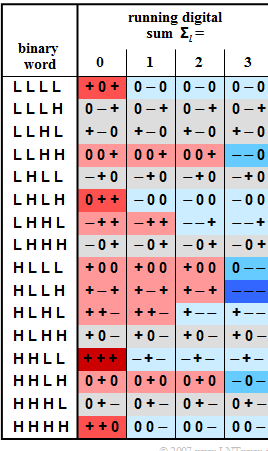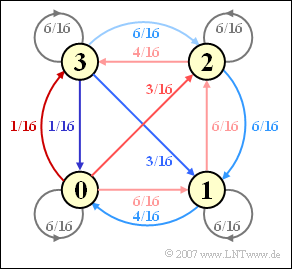Difference between revisions of "Aufgaben:Exercise 1.4Z: Modified MS43 Code"
| Line 3: | Line 3: | ||
}} | }} | ||
| − | [[File: | + | [[File:EN_Dig_A_2_6_v2.png|right|frame|Code table of the MMS43 code]] |
| − | For ISDN data transmission, the MMS43 code is used in Germany and Belgium on the so-called $\rm U_{\rm K0}$ interface (transmission path between the exchange and the NTBA). | + | For ISDN data transmission, the MMS43 code is used in Germany and Belgium on the so-called "$\rm U_{\rm K0}$" interface $($transmission path between the exchange and the NTBA$)$. |
| − | The abbreviation "MMS43" stands for '''M'''odified '''M'''onitored '''S'''um '''4'''B'''3'''T. | + | The abbreviation "MMS43" stands for "'''M'''odified '''M'''onitored '''S'''um '''4'''B'''3'''T". |
| − | This is a 4B3T block code with the four code tables shown in the graphic, which are used for coding according to the so-called "running digital sum" (after $l$ blocks) | + | This is a 4B3T block code with the four code tables shown in the graphic, which are used for coding according to the so-called "running digital sum" $($after $l$ blocks$)$: |
:$${\it \Sigma}\hspace{0.05cm}_l = \sum_{\nu = 1}^{3 \hspace{0.05cm}\cdot \hspace{0.05cm} l}\hspace{0.02cm} a_\nu$$ | :$${\it \Sigma}\hspace{0.05cm}_l = \sum_{\nu = 1}^{3 \hspace{0.05cm}\cdot \hspace{0.05cm} l}\hspace{0.02cm} a_\nu$$ | ||
| − | For initialization | + | For initialization: ${\it \Sigma}_{0} = 0$ is used. |
The colorings in the graph mean: | The colorings in the graph mean: | ||
| − | *If the running digital sum does not change $({\it \Sigma}\hspace{0.05cm}_{l+1} = {\it \Sigma}\hspace{0.05cm} _{l})$, a field is grayed out | + | *If the running digital sum does not change $({\it \Sigma}\hspace{0.05cm}_{l+1} = {\it \Sigma}\hspace{0.05cm} _{l})$, a field is grayed out. |
| − | |||
| − | |||
| + | *An increase $({\it \Sigma}\hspace{0.05cm}_{l+1} > {\it \Sigma}\hspace{0.05cm}_{l})$ is highlighted in red, a decrease $({\it \Sigma}\hspace{0.05cm}_{l+1} < {\it \Sigma}\hspace{0.05cm} _{l})$ in blue. | ||
| + | *The more intense these colors are, the greater the change in the running digital sum. | ||
| Line 24: | Line 24: | ||
| + | Notes: | ||
| − | + | *The exercise belongs to the chapter [[Examples_of_Communication_Systems/ISDN_Basic_Access|"ISDN Basic Access"]]. | |
| − | + | ||
| − | + | *Information about the MMS43 code can be found in the chapter [[Digital_Signal_Transmission/Block_Coding_with_4B3T_Codes|"Block Coding with 4B3T Codes"]] of the book "Digital signal transmission". | |
| − | *The exercise belongs to the chapter [[Examples_of_Communication_Systems/ISDN_Basic_Access|"ISDN Basic Access"]]. | ||
| − | *Information about the MMS43 code can be found in the chapter [[Digital_Signal_Transmission/Block_Coding_with_4B3T_Codes|"Block Coding with 4B3T Codes"]] of the book "Digital signal transmission". | ||
| Line 37: | Line 36: | ||
<quiz display=simple> | <quiz display=simple> | ||
| − | {What are the reasons for using | + | {What are the reasons for using the 4B3T code instead of the redundancy-free binary code in ISDN? |
|type="[]"} | |type="[]"} | ||
- 4B3T is in principle better than the redundancy-free binary code. | - 4B3T is in principle better than the redundancy-free binary code. | ||
| − | + The transmitted signal should be free of | + | + The transmitted signal should be free of DC-signals if the channel frequency response $H_{\rm K}(f = 0) = 0$. |
+ A small symbol rate $(1/T)$ allows a longer cable length. | + A small symbol rate $(1/T)$ allows a longer cable length. | ||
| − | { | + | {Encode the binary sequence "$1100\hspace{0.08cm} 0100 \hspace{0.08cm} 0110 \hspace{0.08cm} 1010$" according to the table. <br>What is the coefficient of the third ternary symbol of the fourth block? |
|type="{}"} | |type="{}"} | ||
$a_{12} \ = \ $ { -1.03--0.97 } | $a_{12} \ = \ $ { -1.03--0.97 } | ||
| − | {Determine the Markov diagram for the transition from ${\it \Sigma}\hspace{0.05cm}_{l}$ to ${\it \Sigma}\hspace{0.05cm}_{l+1}$. What are the transition probabilities? | + | {Determine the Markov diagram for the transition from ${\it \Sigma}\hspace{0.05cm}_{l}$ to ${\it \Sigma}\hspace{0.05cm}_{l+1}$. What are the transition probabilities? |
|type="{}"} | |type="{}"} | ||
${\rm Pr}({\it \Sigma}\hspace{0.05cm}_{l+1} = 0 \ | \ {\it \Sigma}\hspace{0.05cm}_{l}=0) \ = \ $ { 0.375 3% } | ${\rm Pr}({\it \Sigma}\hspace{0.05cm}_{l+1} = 0 \ | \ {\it \Sigma}\hspace{0.05cm}_{l}=0) \ = \ $ { 0.375 3% } | ||
| Line 55: | Line 54: | ||
{What properties follow from the Markov diagram? | {What properties follow from the Markov diagram? | ||
|type="[]"} | |type="[]"} | ||
| − | - The probabilities ${\rm Pr}({\it \Sigma}\hspace{0.05cm}_{l} = 0), \text{ ...} \ , {\rm Pr}({\it \Sigma}\hspace{0.05cm}_{l} = 3)$ are equal. | + | - The probabilities ${\rm Pr}({\it \Sigma}\hspace{0.05cm}_{l} = 0), \text{ ...} \ , {\rm Pr}({\it \Sigma}\hspace{0.05cm}_{l} = 3)$ are equal. |
| − | + | + | + ${\rm Pr}({\it \Sigma}\hspace{0.05cm}_{l} = 0) = {\rm Pr}({\it \Sigma}\hspace{0.05cm}_{l} = 3)$ and ${\rm Pr}({\it \Sigma}\hspace{0.05cm}_{l} = 1) = {\rm Pr}({\it \Sigma}\hspace{0.05cm}_{l} = 2)$ are valid. |
+ The extreme values $(0$ or $3)$ occur less frequently than $1$ or $2$. | + The extreme values $(0$ or $3)$ occur less frequently than $1$ or $2$. | ||
Revision as of 12:00, 20 October 2022
For ISDN data transmission, the MMS43 code is used in Germany and Belgium on the so-called "$\rm U_{\rm K0}$" interface $($transmission path between the exchange and the NTBA$)$.
The abbreviation "MMS43" stands for "Modified Monitored Sum 4B3T".
This is a 4B3T block code with the four code tables shown in the graphic, which are used for coding according to the so-called "running digital sum" $($after $l$ blocks$)$:
- $${\it \Sigma}\hspace{0.05cm}_l = \sum_{\nu = 1}^{3 \hspace{0.05cm}\cdot \hspace{0.05cm} l}\hspace{0.02cm} a_\nu$$
For initialization: ${\it \Sigma}_{0} = 0$ is used.
The colorings in the graph mean:
- If the running digital sum does not change $({\it \Sigma}\hspace{0.05cm}_{l+1} = {\it \Sigma}\hspace{0.05cm} _{l})$, a field is grayed out.
- An increase $({\it \Sigma}\hspace{0.05cm}_{l+1} > {\it \Sigma}\hspace{0.05cm}_{l})$ is highlighted in red, a decrease $({\it \Sigma}\hspace{0.05cm}_{l+1} < {\it \Sigma}\hspace{0.05cm} _{l})$ in blue.
- The more intense these colors are, the greater the change in the running digital sum.
Notes:
- The exercise belongs to the chapter "ISDN Basic Access".
- Information about the MMS43 code can be found in the chapter "Block Coding with 4B3T Codes" of the book "Digital signal transmission".
Questions
Solution
(1) Statements 2 and 3 are correct:
- The first statement is not true: For example, the AWGN channel (additive white Gaussian noise) with a 4B3T code results in a much larger error probability due to the ternary decision compared to the redundancy-free binary code.
- The essential reason for the use of a redundant transmission code is rather that no DC signal component can be transmitted via a "telephone channel".
- The $25 \%$ smaller step rate $(1/T)$ of the 4B3T code also accommodates the transmission characteristics of copper lines (strong increase in attenuation with frequency).
- For a given line attenuation, therefore, a greater length can be bridged with the 4B3T code than with a redundancy-free binary signal.
(2) With the initial value ${\it \Sigma}_{0} = 0$, the 4B3T coding results in:
- 1100 ⇒ "+ + +" ⇒ ${\it \Sigma}_{1} = 3$,
- 0100 ⇒ " – + 0" ⇒ ${\it \Sigma}_{2} = 3$,
- 0110 ⇒ "– – +" ⇒ ${\it \Sigma}_{3} = 2$,
- 1010 ⇒ "+ – –" ⇒ ${\it \Sigma}_{4} = 1$.
Thus, the amplitude coefficient we are looking for is $a_{12}\hspace{0.15cm} \underline{ = \ –1}$.
(3) From the coloring of the given code table, one can determine the following Markov diagram.
- From it, the transition probabilities we are looking for can be read:
- $${\rm Pr}({\it \Sigma}_{l+1} = 0 \ | \ {\it \Sigma}_{l}=0) \ = \ 6/16 \underline{ \ = \ 0.375},$$
- $${\rm Pr}({\it \Sigma}_{l+1} = 2 \ | \ {\it \Sigma}_{l}=0) \ = \ 3/16 \underline{ \ = \ 0.1875},$$
- $${\rm Pr}({\it \Sigma}_{l+1} = 0 \ | \ {\it \Sigma}_{l}=2) \underline{ \ = \ 0}.$$
(4) Statements 2 and 3 are correct:
- The first statement is false, which can be seen from the asymmetries in the Markov diagram.
- On the other hand, there are symmetries with respect to the states "0" and "3" and between "1" and "2".
In the following calculation, instead of ${\rm Pr}({\it \Sigma}_{l} = 0)$, we write ${\rm Pr}(0)$ in a simplified way. Taking advantage of the property ${\rm Pr}(3) = {\rm Pr}(0)$ and ${\rm Pr}(2) = {\rm Pr}(1)$, we get the following equations from the Markov diagram:
- $${\rm Pr}(0)= \frac{6}{16} \cdot {\rm Pr}(0) + \frac{4}{16} \cdot {\rm Pr}(1)+ \frac{1}{16} \cdot {\rm Pr}(3)\hspace{0.3cm} \Rightarrow \hspace{0.3cm}\frac{9}{16} \cdot {\rm Pr}(0)= \frac{4}{16} \cdot {\rm Pr}(1).$$
From the further condition ${\rm Pr}(0) + {\rm Pr}(1) = 1/2$ t follows further:
- $${\rm Pr}(0)= {\rm Pr}(3)= \frac{9}{26}\hspace{0.05cm}, \hspace{0.2cm} {\rm Pr}(1)= {\rm Pr}(2)= \frac{4}{26}\hspace{0.05cm}.$$
This calculation is based on the sum of the incoming arrows in the "0" condition.
One could also give equations for the other three states, but they all give the same result:
- $${\rm Pr}(1) \ = \ \frac{6}{16} \cdot {\rm Pr}(0) + \frac{6}{16} \cdot {\rm Pr}(1)+ \frac{6}{16} \cdot {\rm Pr}(2)+\frac{3}{16} \cdot {\rm Pr}(3)\hspace{0.05cm},$$
- $$ {\rm Pr}(2) \ = \ \frac{3}{16} \cdot {\rm Pr}(0) + \frac{6}{16} \cdot {\rm Pr}(1)+ \frac{6}{16} \cdot {\rm Pr}(2)+\frac{6}{16} \cdot {\rm Pr}(3)\hspace{0.05cm},$$
- $$ {\rm Pr}(3) \ = \ \frac{1}{16} \cdot {\rm Pr}(0) + \frac{4}{16} \cdot {\rm Pr}(2)+\frac{6}{16} \cdot {\rm Pr}(3)\hspace{0.05cm}.$$

